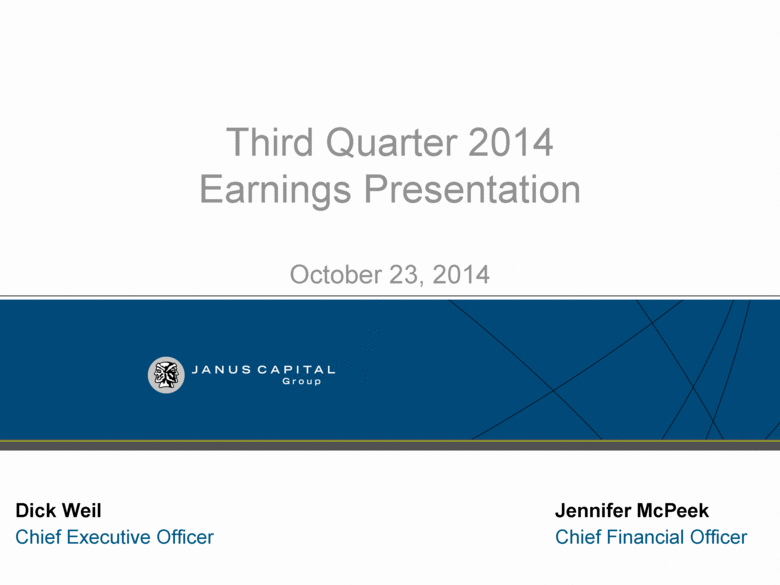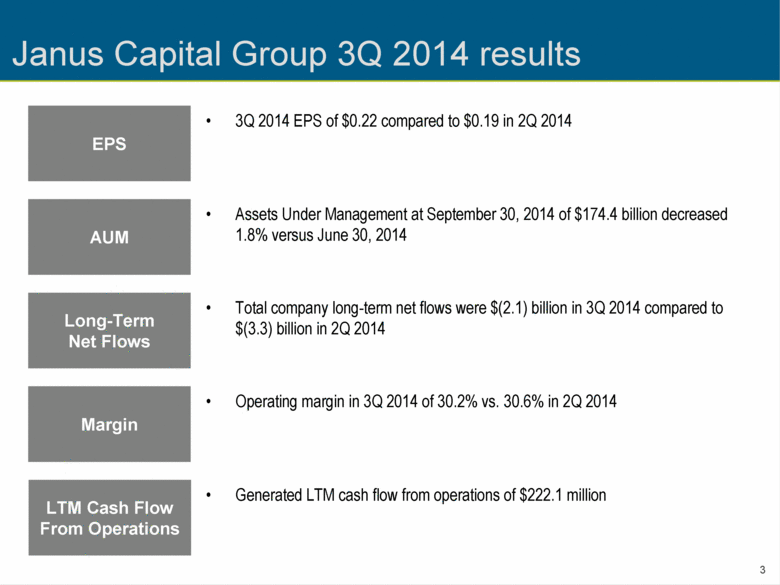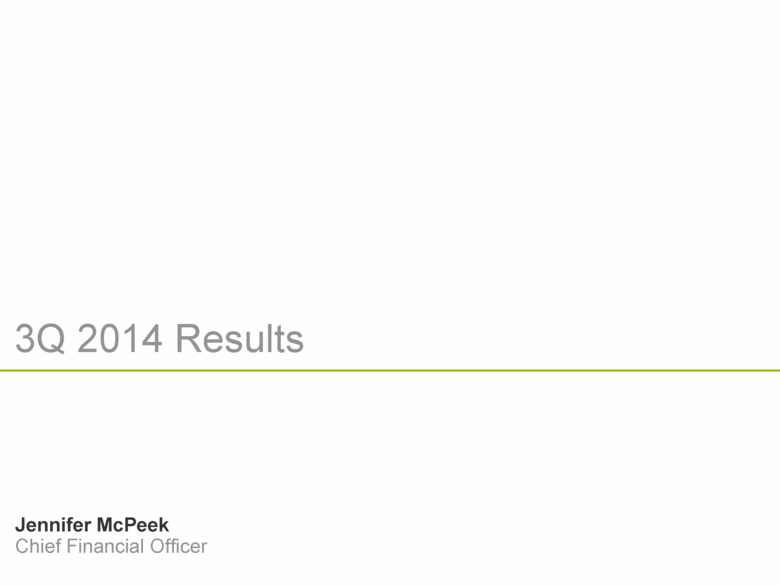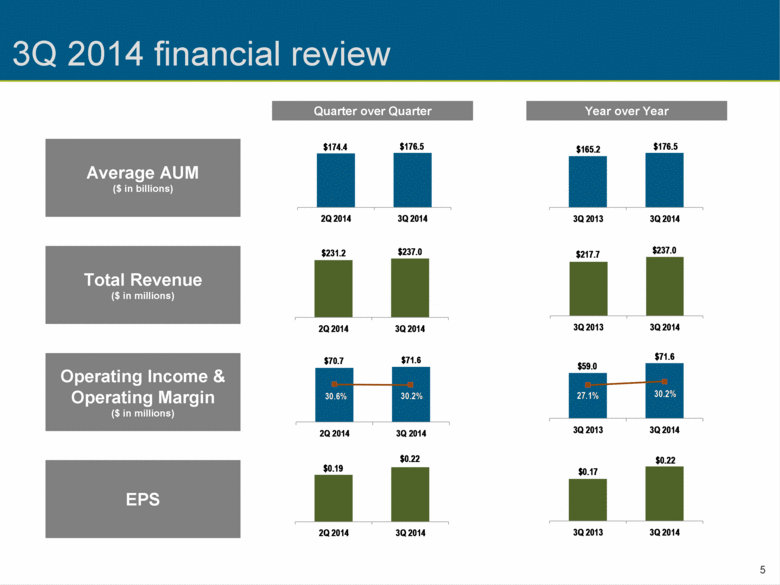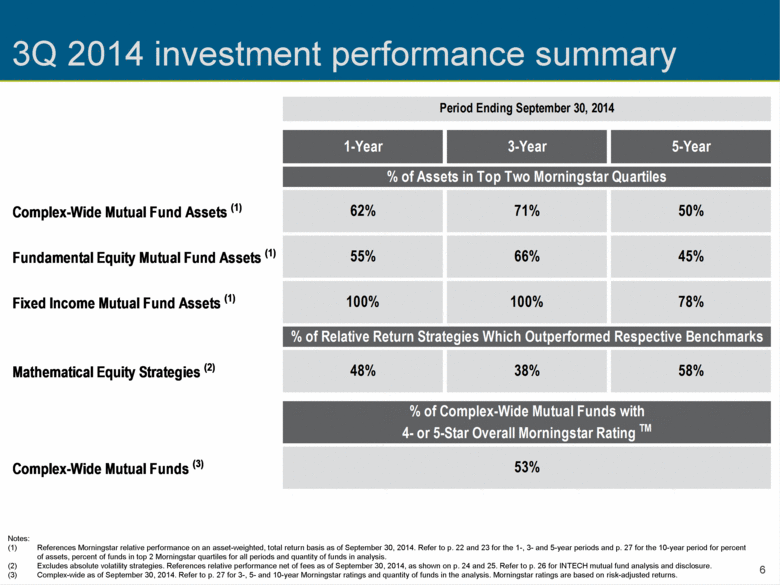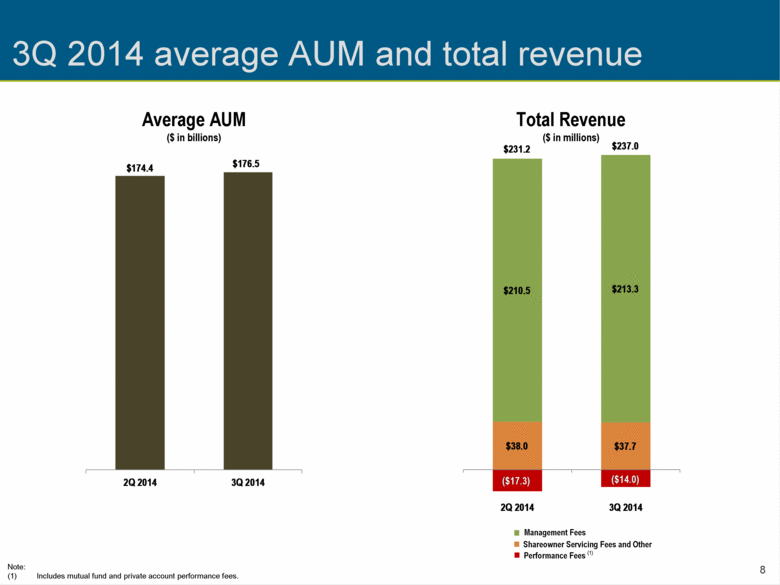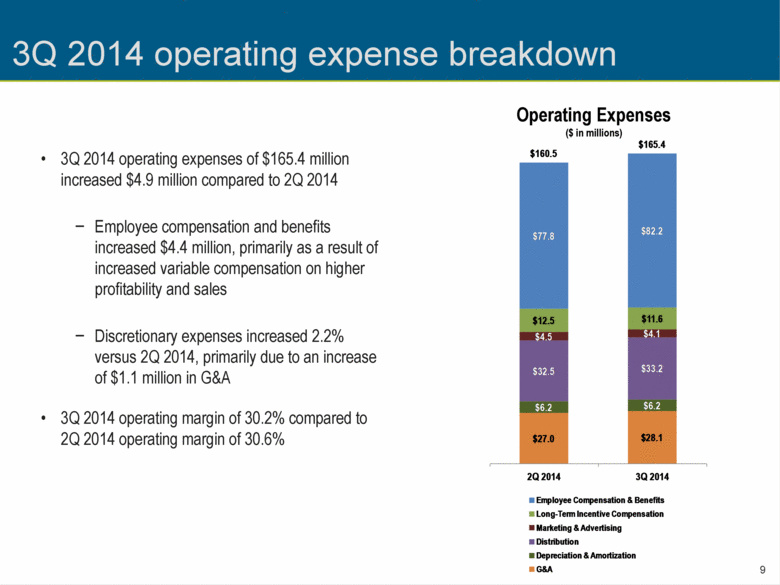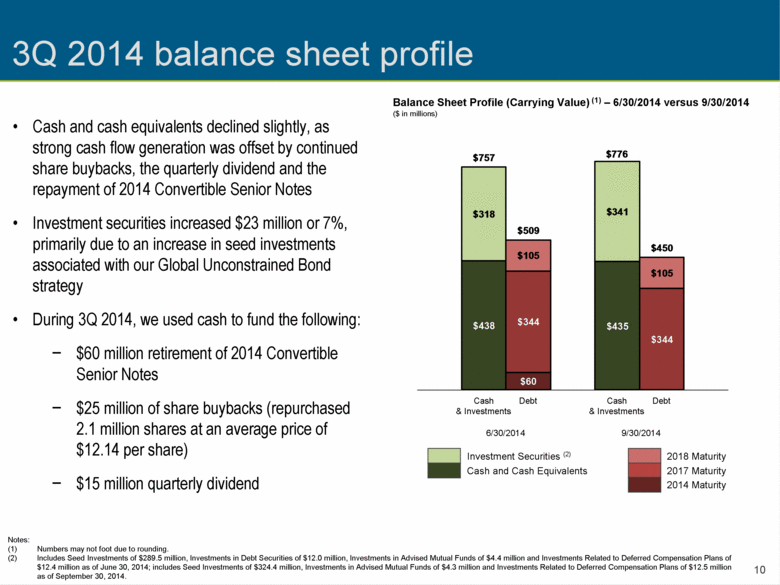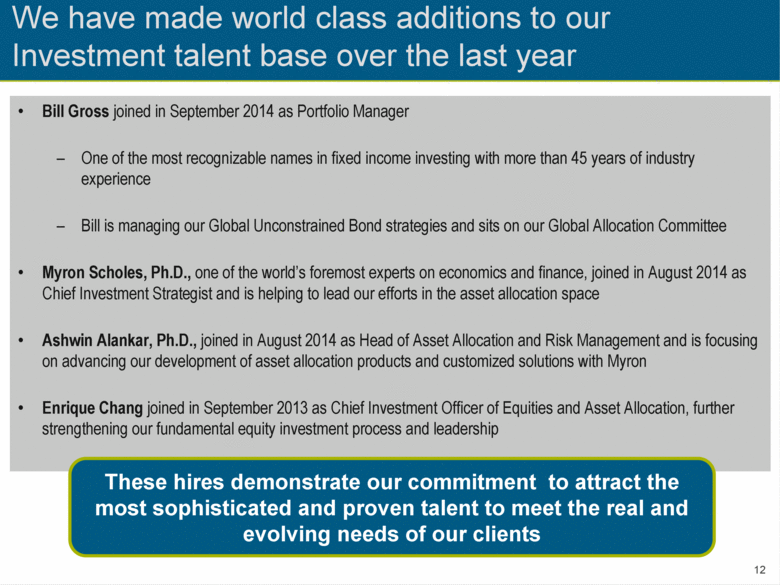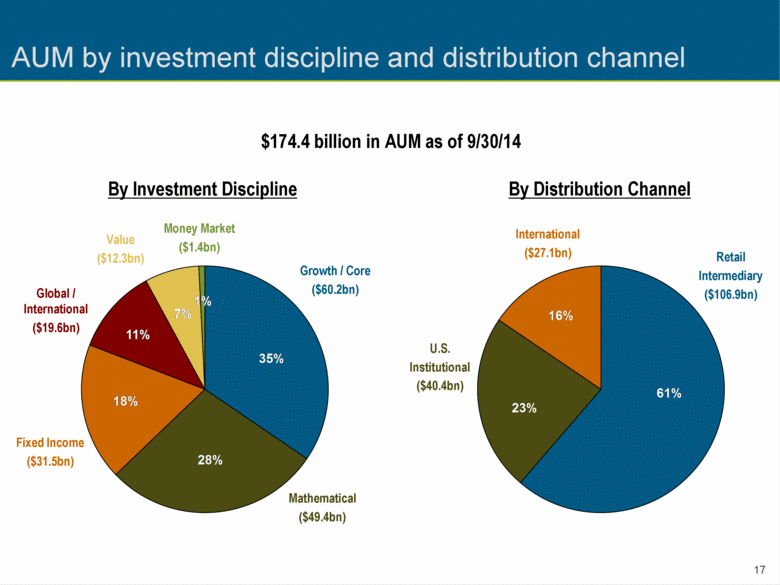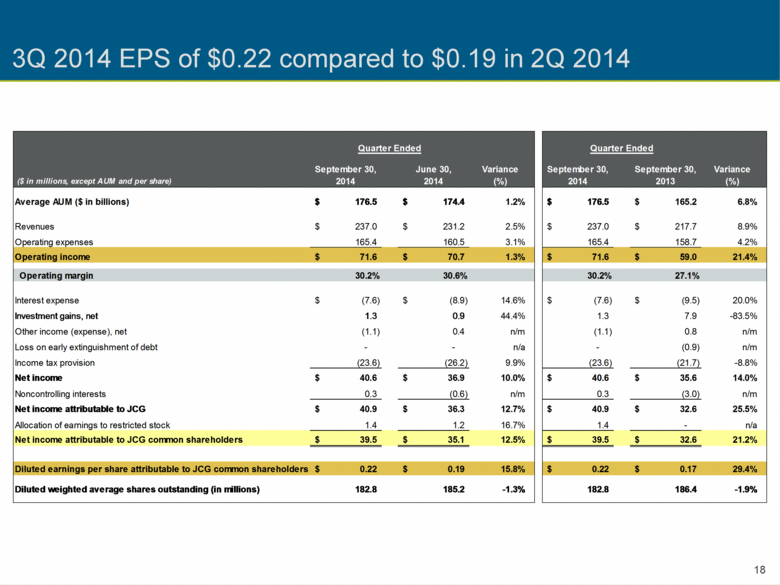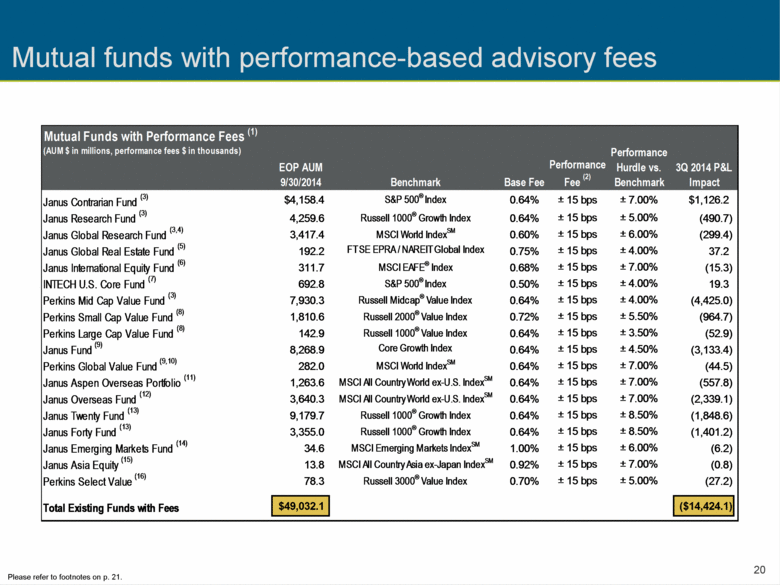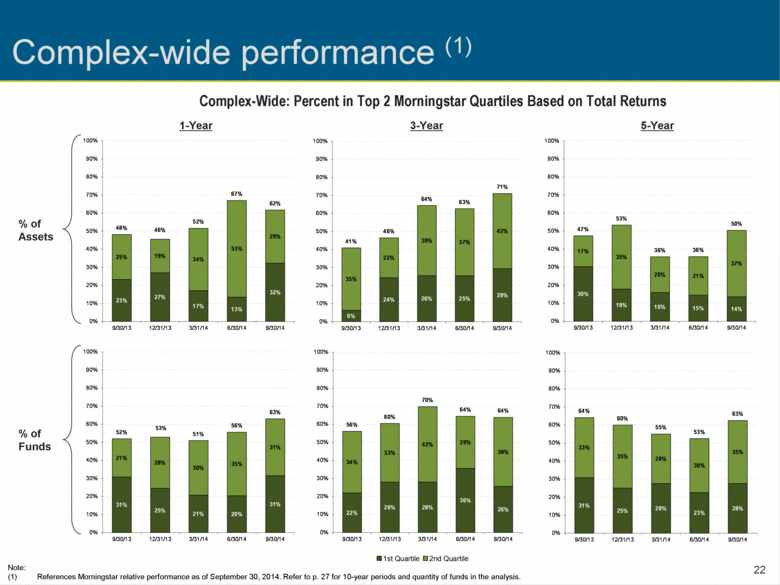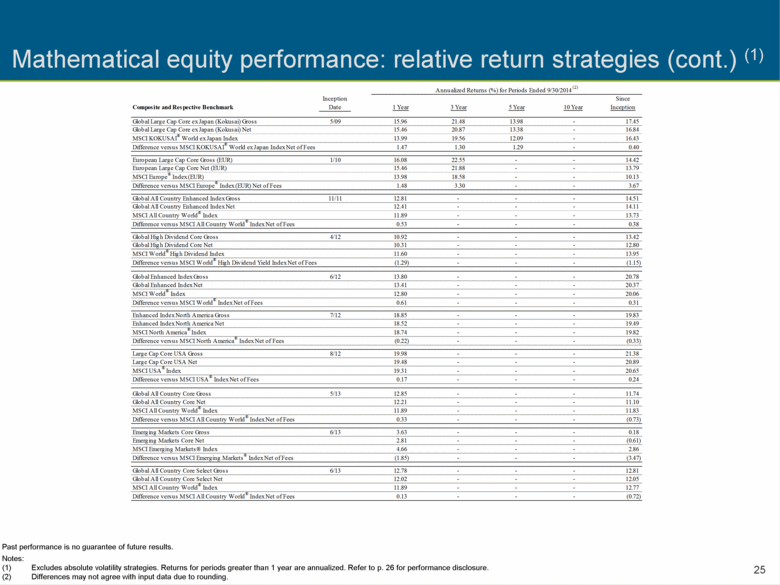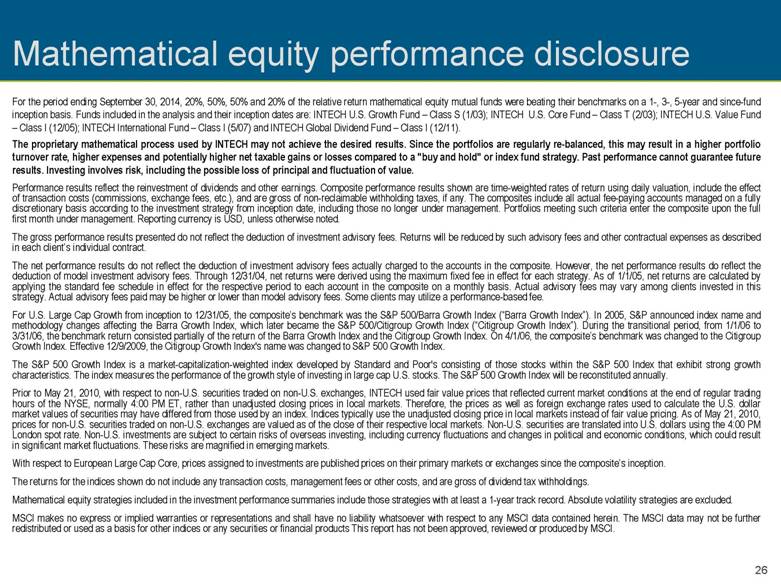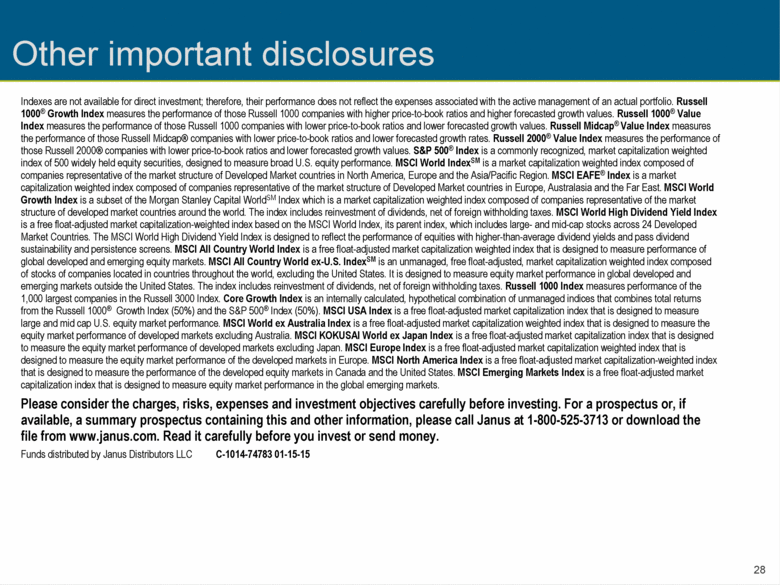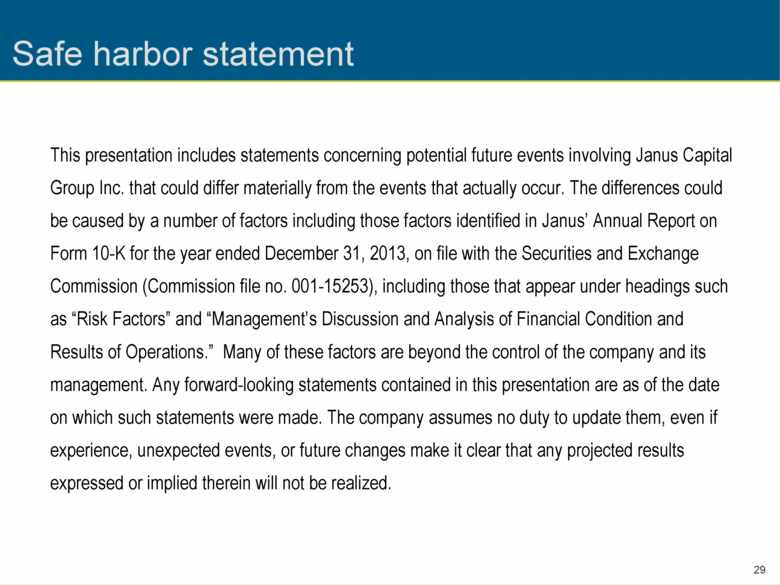Attached files
| file | filename |
|---|---|
| 8-K - 8-K - JANUS CAPITAL GROUP INC | a14-22635_18k.htm |
| EX-99.1 - EX-99.1 - JANUS CAPITAL GROUP INC | a14-22635_1ex99d1.htm |
Exhibit 99.2
|
|
Third Quarter 2014 Earnings Presentation October 23, 2014 Dick Weil Chief Executive Officer Jennifer McPeek Chief Financial Officer |
|
|
Executive summary The hiring of Bill Gross and our acquisition of VelocityShares reflect the continued execution of our strategy of intelligent diversification, as well as our efforts to attract the most sophisticated and proven talent in order to meet needs of our clients 3Q 2014 total company long-term net flows of $(2.1) billion improved quarter over quarter, primarily driven by higher sales across the firm Our operating margin remained above 30% in 3Q 2014 We have further strengthened our balance sheet through the repayment of $60 million of outstanding debt in the third quarter We remain focused on improving investment performance; we are encouraged that more than half of complex-wide funds and assets are in the top two Morningstar quartiles across the 1-, 3-, 5- and 10-year time periods (1) Note: Refer to p. 22 and 23 for the 1-, 3- and 5-year periods and p. 27 for the 10-year period for percent of assets, percent of funds in top 2 Morningstar quartiles for all periods and quantity of funds in analysis. Morningstar rankings are based on total returns. |
|
|
Janus Capital Group 3Q 2014 results EPS AUM Long-Term Net Flows Margin LTM Cash Flow From Operations 3Q 2014 EPS of $0.22 compared to $0.19 in 2Q 2014 Assets Under Management at September 30, 2014 of $174.4 billion decreased 1.8% versus June 30, 2014 Operating margin in 3Q 2014 of 30.2% vs. 30.6% in 2Q 2014 Total company long-term net flows were $(2.1) billion in 3Q 2014 compared to $(3.3) billion in 2Q 2014 Generated LTM cash flow from operations of $222.1 million |
|
|
3Q 2014 Results Jennifer McPeek Chief Financial Officer |
|
|
3Q 2014 financial review EPS Average AUM ($ in billions) Total Revenue ($ in millions) Operating Income & Operating Margin ($ in millions) Quarter over Quarter Year over Year $217.7 $237.0 3Q 2013 3Q 2014 $59.0 $71.6 27.1% 30.2% 3Q 2013 3Q 2014 $165.2 $176.5 3Q 2013 3Q 2014 $0.17 $0.22 3Q 2013 3Q 2014 $231.2 $237.0 2Q 2014 3Q 2014 $174.4 $176.5 2Q 2014 3Q 2014 $70.7 $71.6 2Q 2014 3Q 2014 $0.19 $0.22 2Q 2014 3Q 2014 |
|
|
3Q 2014 investment performance summary Notes: References Morningstar relative performance on an asset-weighted, total return basis as of September 30, 2014. Refer to p. 22 and 23 for the 1-, 3- and 5-year periods and p. 27 for the 10-year period for percent of assets, percent of funds in top 2 Morningstar quartiles for all periods and quantity of funds in analysis. Excludes absolute volatility strategies. References relative performance net of fees as of September 30, 2014, as shown on p. 24 and 25. Refer to p. 26 for INTECH mutual fund analysis and disclosure. Complex-wide as of September 30, 2014. Refer to p. 27 for 3-, 5- and 10-year Morningstar ratings and quantity of funds in the analysis. Morningstar ratings are based on risk-adjusted returns. Period Ending September 30, 2014 1-Year 3-Year 5-Year % of Assets in Top Two Morningstar Quartiles Complex-Wide Mutual Fund Assets (1) 62% 71% 50% Fundamental Equity Mutual Fund Assets (1) 55% 66% 45% Fixed Income Mutual Fund Assets (1) 100% 100% 78% % of Relative Return Strategies Which Outperformed Respective Benchmarks Mathematical Equity Strategies (2) 48% 38% 58% % of Complex-Wide Mutual Funds with 4- or 5-Star Overall Morningstar Rating TM Complex-Wide Mutual Funds (3) 53% |
|
|
3Q 2014 long-term net flow summary Note: Long-term flows exclude money market flows. Annualized sales and redemption rates calculated as a percentage of beginning of period assets. 22% 20% 21% 16% 22% Total Company Long-Term Flows (1) ($ in billions) Mathematical Equity Long-Term Flows (1) ($ in billions) Fundamental Equity Long-Term Flows (1) ($ in billions) Gross Redemptions Gross Sales Net Sales 33% 35% 25% 24% 27% Annualized Redemption Rate Annualized Gross Sales Rate Fixed Income Long-Term Flows (1) ($ in billions) 17% 17% 20% 14% 22% 38% 38% 29% 26% 30% Annualized Redemption Rate Annualized Gross Sales Rate 26% 8% 14% 12% 13% 19% 24% 15% 17% 15% Annualized Redemption Rate Annualized Gross Sales Rate 36% 51% 39% 33% 39% 36% 44% 26% 29% 35% Annualized Redemption Rate Annualized Gross Sales Rate $2.5 $3.6 $2.8 $2.5 $3.1 ($2.5) ($3.1) ($1.8) ($2.2) ($2.8) ($0.0) $0.5 $1.0 $0.3 $0.3 ($8) ($4) $0 $4 $8 3Q13 4Q13 1Q14 2Q14 3Q14 $3.8 $4.0 $4.6 $3.2 $5.2 ($8.7) ($8.9) ($6.9) ($6.2) ($7.3) ($4.9) ($4.9) ($2.3) ($3.0) ($2.1) ($20) ($10) $0 $10 $20 3Q13 4Q13 1Q14 2Q14 3Q14 $2.7 $0.9 $1.6 $1.4 $1.6 ($2.0) ($2.7) ($1.8) ($2.0) ($1.9) $0.7 ($1.8) ($0.2) ($0.6) ($0.3) ($6) ($3) $0 $3 $6 3Q13 4Q13 1Q14 2Q14 3Q14 |
|
|
3Q 2014 average AUM and total revenue Total Revenue ($ in millions) Note: Includes mutual fund and private account performance fees. Average AUM ($ in billions) (1) Management Fees Shareowner Servicing Fees and Other Performance Fees $38.0 $37.7 ($17.3) ($14.0) $210.5 $213.3 $231.2 $237.0 2Q 2014 3Q 2014 $174.4 $176.5 2Q 2014 3Q 2014 |
|
|
3Q 2014 operating expense breakdown 3Q 2014 operating expenses of $165.4 million increased $4.9 million compared to 2Q 2014 Employee compensation and benefits increased $4.4 million, primarily as a result of increased variable compensation on higher profitability and sales Discretionary expenses increased 2.2% versus 2Q 2014, primarily due to an increase of $1.1 million in G&A 3Q 2014 operating margin of 30.2% compared to 2Q 2014 operating margin of 30.6% Operating Expenses ($ in millions) $27.0 $28.1 $6.2 $6.2 $32.5 $33.2 $4.5 $4.1 $12.5 $11.6 $77.8 $82.2 $160.5 $165.4 2Q 2014 3Q 2014 3Q 2011 Employee Compensation & Benefits Long - Term Incentive Compensation Marketing & Advertising Distribution Depreciation & Amortization G&A |
|
|
3Q 2014 balance sheet profile Balance Sheet Profile (Carrying Value) (1) – 6/30/2014 versus 9/30/2014 ($ in millions) 9/30/2014 2017 Maturity Investment Securities (2) 6/30/2014 Cash & Investments Debt Debt Cash and Cash Equivalents Notes: Numbers may not foot due to rounding. Includes Seed Investments of $289.5 million, Investments in Debt Securities of $12.0 million, Investments in Advised Mutual Funds of $4.4 million and Investments Related to Deferred Compensation Plans of $12.4 million as of June 30, 2014; 2014 Maturity Cash and cash equivalents declined slightly, as strong cash flow generation was offset by continued share buybacks, the quarterly dividend and the repayment of 2014 Convertible Senior Notes Investment securities increased $23 million or 7%, primarily due to an increase in seed investments associated with our Global Unconstrained Bond strategy During 3Q 2014, we used cash to fund the following: $60 million retirement of 2014 Convertible Senior Notes $25 million of share buybacks (repurchased 2.1 million shares at an average price of $12.14 per share) $15 million quarterly dividend 2018 Maturity Cash & Investments $438 $435 $318 $341 $757 $776 $60 $344 $344 $105 $105 $509 $450 |
|
|
Topics of Discussion Jennifer McPeek Chief Financial Officer Dick Weil Chief Executive Officer |
|
|
We have made world class additions to our Investment talent base over the last year Bill Gross joined in September 2014 as Portfolio Manager One of the most recognizable names in fixed income investing with more than 45 years of industry experience Bill is managing our Global Unconstrained Bond strategies and sits on our Global Allocation Committee Myron Scholes, Ph.D., one of the world’s foremost experts on economics and finance, joined in August 2014 as Chief Investment Strategist and is helping to lead our efforts in the asset allocation space Ashwin Alankar, Ph.D., joined in August 2014 as Head of Asset Allocation and Risk Management and is focusing on advancing our development of asset allocation products and customized solutions with Myron Enrique Chang joined in September 2013 as Chief Investment Officer of Equities and Asset Allocation, further strengthening our fundamental equity investment process and leadership These hires demonstrate our commitment to attract the most sophisticated and proven talent to meet the real and evolving needs of our clients |
|
|
Bill Gross’ arrival at Janus has created significant near-term opportunities Bill’s decision to join Janus is reshaping the fixed income landscape across the industry Janus Core Plus / Flexible Bond is well positioned to gather flows as a result Janus Global Unconstrained Bond stands to benefit substantially over time across distribution channels and geographies under Bill’s management The news of Bill joining Janus Capital Group is providing a positive effect for Janus Fixed Income, Janus Equity and our Asset Allocation franchise With Bill’s arrival and the acquisition of VelocityShares, we have an opportunity to develop future products in the exchange-traded product (“ETP”) space 1 2 3 4 There are four areas of near-term opportunity: The addition of Bill Gross is strengthening and diversifying Janus’ brand |
|
|
VelocityShares Acquisition Transaction Details Initial upfront cash payment of $30 million to acquire 100% of the Company Will maintain offices in Connecticut and will be integrated with Janus distribution and product development Anticipated closing in 4Q 2014, following customary regulatory review and approval Company Details Founded in 2009; headquartered in Connecticut ~$2 billion in VelocityShares-branded assets, as of September 30, 2014, across 21 ETPs Current ETFs include hedged equity and equal risk weighted products Recognized in the industry for product management and innovation(3) Best Alternative ETF Management Firm Most Innovative North American ETN Provider The addition of VelocityShares further positions us to diversify our product line up and expands the reach of our investment capabilities to a larger client universe Our Interest in ETPs ETPs are among the fastest growing and most demanded vehicles in the marketplace Industry experts estimate that rules-based and active ETPs will grow at an annual rate of 29.5% through 2018(1) – “Not just for passive anymore” Nearly two-thirds of wirehouse advisors and more than half of RIAs report using ETPs, many of them for cost efficiency and sector or thematic allocations(2) Notes: Source: Cerulli Associates. Source: Wells Securities analysis using Morningstar and etf.com data. ETF Express USA Awards 2012. |
|
|
Q&A Jennifer McPeek Chief Financial Officer Dick Weil Chief Executive Officer |
|
|
Appendix |
|
|
AUM by investment discipline and distribution channel $174.4 billion in AUM as of 9/30/14 By Investment Discipline By Distribution Channel Retail Intermediary ($106.9bn) Growth / Core ($60.2bn) Money Market ($1.4bn) Mathematical ($49.4bn) U.S. Institutional ($40.4bn) International ($27.1bn) Fixed Income ($31.5bn) Global / International ($19.6bn) Value ($12.3bn) 61% 23% 16% 35% 28% 18% 11% 7% 1% |
|
|
3Q 2014 EPS of $0.22 compared to $0.19 in 2Q 2014 September 30, June 30, Variance September 30, September 30, Variance ($ in millions, except AUM and per share) 2014 2014 (%) 2014 2013 (%) Average AUM ($ in billions) 176.5 $ 174.4 $ 1.2% 176.5 $ 165.2 $ 6.8% Revenues 237.0 $ 231.2 $ 2.5% 237.0 $ 217.7 $ 8.9% Operating expenses 165.4 160.5 3.1% 165.4 158.7 4.2% Operating income 71.6 $ 70.7 $ 1.3% 71.6 $ 59.0 $ 21.4% Operating margin 30.2% 30.6% 30.2% 27.1% Interest expense (7.6) $ (8.9) $ 14.6% (7.6) $ (9.5) $ 20.0% Investment gains, net 1.3 0.9 44.4% 1.3 7.9 -83.5% Other income (expense), net (1.1) 0.4 n/m (1.1) 0.8 n/m Loss on early extinguishment of debt - - n/a - (0.9) n/m Income tax provision (23.6) (26.2) 9.9% (23.6) (21.7) -8.8% Net income 40.6 $ 36.9 $ 10.0% 40.6 $ 35.6 $ 14.0% Noncontrolling interests 0.3 (0.6) n/m 0.3 (3.0) n/m Net income attributable to JCG 40.9 $ 36.3 $ 12.7% 40.9 $ 32.6 $ 25.5% Allocation of earnings to restricted stock 1.4 1.2 16.7% 1.4 - n/a Net income attributable to JCG common shareholders 39.5 $ 35.1 $ 12.5% 39.5 $ 32.6 $ 21.2% Diluted earnings per share attributable to JCG common shareholders 0.22 $ 0.19 $ 15.8% 0.22 $ 0.17 $ 29.4% Diluted weighted average shares outstanding (in millions) 182.8 185.2 -1.3% 182.8 186.4 -1.9% Quarter Ended Quarter Ended |
|
|
3Q 2014 operating margin of 30.2% versus 30.6% in 2Q 2014 September 30, June 30, Variance September 30, September 30, Variance ($ in millions, except AUM) 2014 2014 (%) 2014 2013 (%) Average AUM ($ in billions) 176.5 $ 174.4 $ 1.2% 176.5 $ 165.2 $ 6.8% Revenues Investment management fees 213.3 $ 210.5 $ 213.3 $ 204.0 $ Performance fees - mutual funds (14.4) (17.9) (14.4) (22.3) Performance fees - private accounts 0.4 0.6 0.4 0.3 Shareowner servicing fees and other 37.7 38.0 37.7 35.7 Total revenues 237.0 $ 231.2 $ 2.5% 237.0 $ 217.7 $ 8.9% Basis points Investment management fees 47.9 48.4 47.9 49.0 Investment management fees and performance fees 44.8 44.4 44.8 43.7 Operating expenses Employee compensation and benefits 82.2 $ 77.8 $ 82.2 $ 73.3 $ Long-term incentive compensation 11.6 12.5 11.6 15.8 Marketing and advertising 4.1 4.5 4.1 4.6 Distribution 33.2 32.5 33.2 30.8 Depreciation and amortization 6.2 6.2 6.2 7.1 General, administrative and occupancy 28.1 27.0 28.1 27.1 Total operating expenses 165.4 $ 160.5 $ 3.1% 165.4 $ 158.7 $ 4.2% Operating income 71.6 $ 70.7 $ 1.3% 71.6 $ 59.0 $ 21.4% Operating margin 30.2% 30.6% 30.2% 27.1% Quarter Ended Quarter Ended |
|
|
Mutual funds with performance-based advisory fees Please refer to footnotes on p. 21. Mutual Funds with Performance Fees (1) (AUM $ in millions, performance fees $ in thousands) EOP AUM 9/30/2014 Benchmark Base Fee Performance Fee (2) Performance Hurdle vs. Benchmark 3Q 2014 P&L Impact Janus Contrarian Fund (3) $4,158.4 S&P 500 ® Index 0.64% ± 15 bps ± 7.00% $1,126.2 Janus Research Fund (3) 4,259.6 Russell 1000 ® Growth Index 0.64% ± 15 bps ± 5.00% (490.7) Janus Global Research Fund (3,4) 3,417.4 MSCI World Index SM 0.60% ± 15 bps ± 6.00% (299.4) Janus Global Real Estate Fund (5) 192.2 FTSE EPRA / NAREITGlobal Index 0.75% ± 15 bps ± 4.00% 37.2 Janus International Equity Fund (6) 311.7 MSCI EAFE ® Index 0.68% ± 15 bps ± 7.00% (15.3) INTECH U.S. Core Fund (7) 692.8 S&P 500 ® Index 0.50% ± 15 bps ± 4.00% 19.3 Perkins Mid Cap Value Fund (3) 7,930.3 Russell Midcap ® Value Index 0.64% ± 15 bps ± 4.00% (4,425.0) Perkins Small Cap Value Fund (8) 1,810.6 Russell 2000 ® Value Index 0.72% ± 15 bps ± 5.50% (964.7) Perkins Large Cap Value Fund (8) 142.9 Russell 1000 ® Value Index 0.64% ± 15 bps ± 3.50% (52.9) Janus Fund (9) 8,268.9 Core Growth Index 0.64% ± 15 bps ± 4.50% (3,133.4) Perkins Global Value Fund (9,10) 282.0 MSCI World Index SM 0.64% ± 15 bps ± 7.00% (44.5) Janus Aspen Overseas Portfolio (11) 1,263.6 MSCI All Country World ex-U.S. Index SM 0.64% ± 15 bps ± 7.00% (557.8) Janus Overseas Fund (12) 3,640.3 MSCI All Country World ex-U.S. Index SM 0.64% ± 15 bps ± 7.00% (2,339.1) Janus Twenty Fund (13) 9,179.7 Russell 1000 ® Growth Index 0.64% ± 15 bps ± 8.50% (1,848.6) Janus Forty Fund (13) 3,355.0 Russell 1000 ® Growth Index 0.64% ± 15 bps ± 8.50% (1,401.2) Janus Emerging Markets Fund (14) 34.6 MSCI Emerging Markets Index SM 1.00% ± 15 bps ± 6.00% (6.2) Janus Asia Equity (15) 13.8 MSCI All Country Asia ex-Japan Index SM 0.92% ± 15 bps ± 7.00% (0.8) Perkins Select Value (16) 78.3 Russell 3000 ® Value Index 0.70% ± 15 bps ± 5.00% (27.2) Total Existing Funds with Fees $49,032.1 ($14,424.1) |
|
|
Mutual funds with performance-based advisory fees (cont.) Notes: The funds listed have a performance-based investment advisory fee that adjusts upward or downward based on each fund’s performance relative to an approved benchmark index over a performance measurement period. Please see the funds’ Statements of Additional Information for more details. Actual performance measurement periods used for calculating the performance fees are from 12 months up to 36 months, and then over 36-month rolling periods. Adjustment of ± 15 bps assumes constant assets and could be higher or lower depending on asset fluctuations. The performance measurement period began on 2/1/2006, and the performance adjustment was implemented as of 2/1/2007. Effective close of business on March 15, 2013, Janus Global Research Fund merged with and into Janus Worldwide Fund; following the merger, Janus Worldwide Fund was renamed Janus Global Research Fund (the “Combined Fund”). The Combined Fund’s surviving performance track record is that of the former Janus Global Research Fund, and the performance measurement benchmark is the MSCI World Index. For three years after the merger, Janus will waive its management fee to at least a level that is equivalent to the fee rate the Combined Fund would have paid if, after the merger, the performance history of Janus Worldwide Fund were used to calculate the performance fee adjustment to the base management fee. The performance measurement period began on 12/1/2007 and the performance adjustment was implemented as of 12/1/2008. Beginning 7/1/2010, Janus Global Real Estate Fund’s benchmark index changed from the FTSE EPRA/NAREIT Developed Index to the FTSE EPRA/NAREIT Global Index for purposes of measuring the Fund’s performance and calculating the performance adjustment. Because the Fund’s performance adjustment is based upon a rolling 36-month performance measurement period, comparisons to the FTSE EPRA/NAREIT Global Index will not be fully implemented until 36 months after July 1, 2010. During this transition period, the Fund's returns will be compared to a blended index return. The performance measurement period began on 12/1/2006, and the performance adjustment was implemented as of 12/1/2007. The performance measurement period began on 1/1/2006, and the performance adjustment was implemented as of 1/1/2007. Effective 12/7/11, INTECH Risk-Managed Core Fund was renamed INTECH U.S. Core Fund. The performance measurement period began on 1/1/2009, and the performance adjustment was implemented as of 1/1/2010. The performance measurement period began on 7/1/2010, and the performance adjustment was implemented as of 6/30/2011. Effective 7/1/10, Janus Global Opportunities Fund was renamed Perkins Global Value Fund. The performance measurement period began on 7/1/2010, and the performance adjustment was implemented as of 9/30/2011. The performance measurement period began on 8/1/2010, and the performance adjustment was implemented as of 10/31/2011. The performance measurement period began on 7/1/2010, and the performance adjustment was implemented as of 12/31/2011. The performance measurement period began on 12/31/2010, and the performance adjustment was implemented as of 12/31/2011. The performance measurement period began on 7/29/2011, and the performance adjustment was implemented as of 7/31/2012. The performance measurement period began on 1/1/2012, and the performance adjustment was implemented as of 12/31/2012. |
|
|
Complex-Wide: Percent in Top 2 Morningstar Quartiles Based on Total Returns 1-Year 3-Year 5-Year % of Funds % of Assets Complex-wide performance (1) Note: References Morningstar relative performance as of September 30, 2014. Refer to p. 27 for 10-year periods and quantity of funds in the analysis. 46% 61% 63% 61% 48% 24% 27% 31% 33% 39% 88% 94% 88% 94% 71% 0% 10% 20% 30% 40% 50% 60% 70% 80% 90% 100% 3/31/09 6/30/09 9/30/09 12/31/09 3/31/10 Percent of Janus Managed Equity JIF Funds . 1st Quartile 2nd Quartile 46% 61% 63% 61% 48% 24% 27% 31% 33% 39% 88% 94% 88% 94% 71% 0% 10% 20% 30% 40% 50% 60% 70% 80% 90% 100% 3/31/09 6/30/09 9/30/09 12/31/09 3/31/10 Percent of Janus Managed Equity JIF Funds . 1st Quartile 2nd Quartile 31% 25% 21% 20% 31% 21% 28% 30% 35% 31% 52% 53% 51% 56% 63% 0% 10% 20% 30% 40% 50% 60% 70% 80% 90% 100% 9/30/13 12/31/13 3/31/14 6/30/14 9/30/14 31% 25% 28% 23% 28% 33% 35% 28% 30% 35% 64% 60% 55% 53% 63% 0% 10% 20% 30% 40% 50% 60% 70% 80% 90% 100% 9/30/13 12/31/13 3/31/14 6/30/14 9/30/14 6% 24% 26% 25% 29% 35% 22% 39% 37% 42% 41% 46% 64% 63% 71% 0% 10% 20% 30% 40% 50% 60% 70% 80% 90% 100% 9/30/13 12/31/13 3/31/14 6/30/14 9/30/14 22% 28% 28% 36% 26% 34% 33% 42% 29% 38% 56% 60% 70% 64% 64% 0% 10% 20% 30% 40% 50% 60% 70% 80% 90% 100% 9/30/13 12/31/13 3/31/14 6/30/14 9/30/14 30% 18% 16% 15% 14% 17% 35% 20% 21% 37% 47% 53% 36% 36% 50% 0% 10% 20% 30% 40% 50% 60% 70% 80% 90% 100% 9/30/13 12/31/13 3/31/14 6/30/14 9/30/14 |
|
|
Fundamental Equity: Percent in Top 2 Morningstar Quartiles Based on Total Returns Fundamental equity performance (1) 1-Year 3-Year 5-Year % of Funds % of Assets Note: References Morningstar relative performance as of September 30, 2014. Refer to p. 27 for 10-year periods and quantity of funds in the analysis. 46% 61% 63% 61% 48% 24% 27% 31% 33% 39% 88% 94% 88% 94% 71% 0% 10% 20% 30% 40% 50% 60% 70% 80% 90% 100% 3/31/09 6/30/09 9/30/09 12/31/09 3/31/10 Percent of Janus Managed Equity JIF Funds . 1st Quartile 2nd Quartile 15% 20% 9% 12% 34% 25% 17% 35% 51% 21% 41% 38% 44% 63% 55% 0% 10% 20% 30% 40% 50% 60% 70% 80% 90% 100% 9/30/13 12/31/13 3/31/14 6/30/14 9/30/14 27% 20% 18% 16% 14% 12% 33% 15% 13% 31% 39% 54% 32% 29% 45% 0% 10% 20% 30% 40% 50% 60% 70% 80% 90% 100% 9/30/13 12/31/13 3/31/14 6/30/14 9/30/14 15% 18% 18% 29% 24% 30% 32% 44% 29% 35% 45% 50% 62% 57% 59% 0% 10% 20% 30% 40% 50% 60% 70% 80% 90% 100% 9/30/13 12/31/13 3/31/14 6/30/14 9/30/14 6% 20% 21% 20% 33% 26% 19% 38% 36% 33% 32% 39% 59% 57% 66% 0% 10% 20% 30% 40% 50% 60% 70% 80% 90% 100% 9/30/13 12/31/13 3/31/14 6/30/14 9/30/14 32% 31% 28% 22% 22% 23% 31% 22% 22% 34% 55% 63% 50% 44% 56% 0% 10% 20% 30% 40% 50% 60% 70% 80% 90% 100% 9/30/13 12/31/13 3/31/14 6/30/14 9/30/14 |
|
|
Mathematical equity performance: relative return strategies (1) Past performance is no guarantee of future results. Notes: Excludes absolute volatility strategies. Returns for periods greater than 1 year are annualized. Refer to p. 26 for performance disclosure. Differences may not agree with input data due to rounding. Inception Since Composite and Respective Benchmark Date 1 Year 3 Year 5 Year 10 Year Inception U.S. Enhanced Plus Gross 7/87 20.76 23.18 16.33 8.93 10.92 U.S. Enhanced Plus Net 20.42 22.82 15.98 8.60 10.52 S&P 500 ® Index 19.74 22.99 15.70 8.11 9.55 Difference versus S&P 500 ® Index Net of Fees 0.69 (0.17) 0.28 0.49 0.97 U.S. Large Cap Growth Gross 7/93 20.03 22.16 16.45 8.58 12.85 U.S. Large Cap Growth Net 19.46 21.59 15.91 8.08 12.28 S&P 500 ® Growth Index 21.55 22.62 16.64 8.83 9.46 Difference versus S&P 500 ® Growth Index Net of Fees (2.09) (1.03) (0.73) (0.75) 2.82 U.S. Enhanced Index Gross 4/98 19.30 22.81 15.88 8.64 6.52 U.S. Enhanced Index Net 18.95 22.43 15.51 8.31 6.17 S&P 500 ® Index 19.74 22.99 15.70 8.11 5.52 Difference versus S&P 500 ® Index Net of Fees (0.79) (0.56) (0.19) 0.20 0.65 U.S. Broad Large Cap Growth Gross 11/00 16.94 21.99 17.03 8.54 4.53 U.S. Broad Large Cap Growth Net 16.37 21.39 16.45 8.00 3.99 Russell 1000 ® Growth Index 19.15 22.45 16.50 8.94 2.50 Difference versus Russell 1000 ® Growth Index Net of Fees (2.78) (1.06) (0.06) (0.94) 1.50 U.S. Broad Enhanced Plus Gross 4/01 18.44 22.96 16.45 8.74 7.60 U.S. Broad Enhanced Plus Net 18.08 22.57 16.09 8.42 7.26 Russell 1000 ® Index 19.01 23.23 15.90 8.46 6.46 Difference versus Russell 1000 ® Index Net of Fees (0.93) (0.66) 0.19 (0.04) 0.80 U.S. Large Cap Core Gross 8/01 18.90 22.49 15.85 8.75 7.44 U.S. Large Cap Core Net 18.32 21.90 15.29 8.24 6.94 S&P 500 ® Index 19.74 22.99 15.70 8.11 5.86 Difference versus S&P 500 ® Index Net of Fees (1.42) (1.09) (0.41) 0.13 1.08 U.S. Broad Large Cap Value Gross 8/04 16.95 24.10 16.23 8.78 9.03 U.S. Broad Large Cap Value Net 16.53 23.64 15.79 8.37 8.62 Russell 1000 ® Value Index 18.89 23.93 15.26 7.84 8.02 Difference versus Russell 1000 ® Value Index Net of Fees (2.36) (0.29) 0.53 0.53 0.61 Global Large Cap Core Gross 1/05 13.49 20.41 13.26 - 8.39 Global Large Cap Core Net 12.98 19.86 12.71 - 7.83 MSCI World ® Index 12.80 18.60 11.48 - 6.66 Difference versus MSCI World ® Index Net of Fees 0.18 1.26 1.24 - 1.17 Enhanced Plus USA Gross 1/06 19.78 23.54 16.88 - 7.98 Enhanced Plus USA Net 19.40 23.14 16.50 - 7.64 MSCI USA ® Index 19.31 23.01 15.77 - 7.72 Difference versus MSCI USA ® Index Net of Fees 0.09 0.14 0.73 - (0.08) International Large Cap Core Gross 11/06 5.12 16.74 9.09 - 4.98 International Large Cap Core Net 4.69 16.25 8.63 - 4.54 MSCI EAFE ® Index 4.70 14.16 7.04 - 2.65 Difference versus MSCI EAFE ® Index Net of Fees (0.01) 2.09 1.59 - 1.89 U.S. Broad Enhanced Index Gross 10/08 18.57 23.07 16.05 - 11.71 U.S. Broad Enhanced Index Net 18.31 22.80 15.77 - 11.43 Russell 1000 ® Index 19.01 23.23 15.90 - 11.90 Difference versus Russell 1000 ® Index Net of Fees (0.70) (0.43) (0.13) - (0.47) Annualized Returns (%) for Periods Ended 9/30/2014 (2) |
|
|
Mathematical equity performance: relative return strategies (cont.) (1) Past performance is no guarantee of future results. Notes: Excludes absolute volatility strategies. Returns for periods greater than 1 year are annualized. Refer to p. 26 for performance disclosure. Differences may not agree with input data due to rounding. Inception Since Composite and Respective Benchmark Date 1 Year 3 Year 5 Year 10 Year Inception Global Large Cap Core ex Japan (Kokusai) Gross 5/09 15.96 21.48 13.98 - 17.45 Global Large Cap Core ex Japan (Kokusai) Net 15.46 20.87 13.38 - 16.84 MSCI KOKUSAI ® World ex Japan Index 13.99 19.56 12.09 - 16.43 Difference versus MSCI KOKUSAI ® World ex Japan Index Net of Fees 1.47 1.30 1.29 - 0.40 European Large Cap Core Gross (EUR) 1/10 16.08 22.55 - - 14.42 European Large Cap Core Net (EUR) 15.46 21.88 - - 13.79 MSCI Europe ® Index (EUR) 13.98 18.58 - - 10.13 Difference versus MSCI Europe ® Index (EUR) Net of Fees 1.48 3.30 - - 3.67 Global All Country Enhanced Index Gross 11/11 12.81 - - - 14.51 Global All Country Enhanced Index Net 12.41 - - - 14.11 MSCI All Country World ® Index 11.89 - - - 13.73 Difference versus MSCI All Country World ® Index Net of Fees 0.53 - - - 0.38 Global High Dividend Core Gross 4/12 10.92 - - - 13.42 Global High Dividend Core Net 10.31 - - - 12.80 MSCI World ® High Dividend Index 11.60 - - - 13.95 Difference versus MSCI World ® High Dividend Yield Index Net of Fees (1.29) - - - (1.15) Global Enhanced Index Gross 6/12 13.80 - - - 20.78 Global Enhanced Index Net 13.41 - - - 20.37 MSCI World ® Index 12.80 - - - 20.06 Difference versus MSCI World ® Index Net of Fees 0.61 - - - 0.31 Enhanced Index North America Gross 7/12 18.85 - - - 19.83 Enhanced Index North America Net 18.52 - - - 19.49 MSCI North America ® Index 18.74 - - - 19.82 Difference versus MSCI North America ® Index Net of Fees (0.22) - - - (0.33) Large Cap Core USA Gross 8/12 19.98 - - - 21.38 Large Cap Core USA Net 19.48 - - - 20.89 MSCI USA ® Index 19.31 - - - 20.65 Difference versus MSCI USA ® Index Net of Fees 0.17 - - - 0.24 Global All Country Core Gross 5/13 12.85 - - - 11.74 Global All Country Core Net 12.21 - - - 11.10 MSCI All Country World ® Index 11.89 - - - 11.83 Difference versus MSCI All Country World ® Index Net of Fees 0.33 - - - (0.73) Emerging Markets Core Gross 6/13 3.63 - - - 0.18 Emerging Markets Core Net 2.81 - - - (0.61) MSCI Emerging Markets® Index 4.66 - - - 2.86 Difference versus MSCI Emerging Markets ® Index Net of Fees (1.85) - - - (3.47) Global All Country Core Select Gross 6/13 12.78 - - - 12.81 Global All Country Core Select Net 12.02 - - - 12.05 MSCI All Country World ® Index 11.89 - - - 12.77 Difference versus MSCI All Country World ® Index Net of Fees 0.13 - - - (0.72) Annualized Returns (%) for Periods Ended 9/30/2014 (2) |
|
|
Mathematical equity performance disclosure For the period ending September 30, 2014, 20%, 50%, 50% and 20% of the relative return mathematical equity mutual funds were beating their benchmarks on a 1-, 3-, 5-year and since-fund inception basis. Funds included in the analysis and their inception dates are: INTECH U.S. Growth Fund – Class S (1/03); INTECH U.S. Core Fund – Class T (2/03); INTECH U.S. Value Fund – Class I (12/05); INTECH International Fund – Class I (5/07) and INTECH Global Dividend Fund – Class I (12/11). The proprietary mathematical process used by INTECH may not achieve the desired results. Since the portfolios are regularly re-balanced, this may result in a higher portfolio turnover rate, higher expenses and potentially higher net taxable gains or losses compared to a "buy and hold" or index fund strategy. Past performance cannot guarantee future results. Investing involves risk, including the possible loss of principal and fluctuation of value. Performance results reflect the reinvestment of dividends and other earnings. Composite performance results shown are time-weighted rates of return using daily valuation, include the effect of transaction costs (commissions, exchange fees, etc.), and are gross of non-reclaimable withholding taxes, if any. The composites include all actual fee-paying accounts managed on a fully discretionary basis according to the investment strategy from inception date, including those no longer under management. Portfolios meeting such criteria enter the composite upon the full first month under management. Reporting currency is USD, unless otherwise noted. The gross performance results presented do not reflect the deduction of investment advisory fees. Returns will be reduced by such advisory fees and other contractual expenses as described in each client’s individual contract. The net performance results do not reflect the deduction of investment advisory fees actually charged to the accounts in the composite. However, the net performance results do reflect the deduction of model investment advisory fees. Through 12/31/04, net returns were derived using the maximum fixed fee in effect for each strategy. As of 1/1/05, net returns are calculated by applying the standard fee schedule in effect for the respective period to each account in the composite on a monthly basis. Actual advisory fees may vary among clients invested in this strategy. Actual advisory fees paid may be higher or lower than model advisory fees. Some clients may utilize a performance-based fee. For U.S. Large Cap Growth from inception to 12/31/05, the composite’s benchmark was the S&P 500/Barra Growth Index (“Barra Growth Index”). In 2005, S&P announced index name and methodology changes affecting the Barra Growth Index, which later became the S&P 500/Citigroup Growth Index (“Citigroup Growth Index”). During the transitional period, from 1/1/06 to 3/31/06, the benchmark return consisted partially of the return of the Barra Growth Index and the Citigroup Growth Index. On 4/1/06, the composite’s benchmark was changed to the Citigroup Growth Index. Effective 12/9/2009, the Citigroup Growth Index's name was changed to S&P 500 Growth Index. The S&P 500 Growth Index is a market-capitalization-weighted index developed by Standard and Poor's consisting of those stocks within the S&P 500 Index that exhibit strong growth characteristics. The index measures the performance of the growth style of investing in large cap U.S. stocks. The S&P 500 Growth Index will be reconstituted annually. Prior to May 21, 2010, with respect to non-U.S. securities traded on non-U.S. exchanges, INTECH used fair value prices that reflected current market conditions at the end of regular trading hours of the NYSE, normally 4:00 PM ET, rather than unadjusted closing prices in local markets. Therefore, the prices as well as foreign exchange rates used to calculate the U.S. dollar market values of securities may have differed from those used by an index. Indices typically use the unadjusted closing price in local markets instead of fair value pricing. As of May 21, 2010, prices for non-U.S. securities traded on non-U.S. exchanges are valued as of the close of their respective local markets. Non-U.S. securities are translated into U.S. dollars using the 4:00 PM London spot rate. Non-U.S. investments are subject to certain risks of overseas investing, including currency fluctuations and changes in political and economic conditions, which could result in significant market fluctuations. These risks are magnified in emerging markets. With respect to European Large Cap Core, prices assigned to investments are published prices on their primary markets or exchanges since the composite’s inception. The returns for the indices shown do not include any transaction costs, management fees or other costs, and are gross of dividend tax withholdings. Mathematical equity strategies included in the investment performance summaries include those strategies with at least a 1-year track record. Absolute volatility strategies are excluded. MSCI makes no express or implied warranties or representations and shall have no liability whatsoever with respect to any MSCI data contained herein. The MSCI data may not be further redistributed or used as a basis for other indices or any securities or financial products This report has not been approved, reviewed or produced by MSCI. |
|
|
Other important disclosures Data presented reflects past performance, which is no guarantee of future results. Due to market volatility, current performance may be higher or lower than the performance shown. Call 877.33JANUS (52687) or visit janus.com/advisor/mutual-funds for performance, rankings and ratings current to the most recent month-end. Janus Capital Group Inc. (“JCG”) provides investment advisory services through its primary subsidiaries, Janus Capital Management LLC (“Janus”), INTECH Investment Management LLC (“INTECH”) and Perkins Investment Management LLC (“Perkins”). “Complex-Wide Mutual Funds” means all affiliated mutual funds managed by Janus, INTECH and Perkins. “Fundamental Equity Mutual Funds” means all mutual funds managed by Janus or Perkins that invest in equity securities. “Fixed Income Mutual Funds” means all mutual funds managed by Janus that invest primarily in fixed income securities. “Mathematical Equity Strategies” means all relative return, discretionary managed accounts (not mutual funds) that are advised or sub-advised by INTECH. Mutual fund relative performance analysis shown is for each Fund's parent share class (typically the share class with the longest performance history): Class T, S or I Shares in the Janus retail fund (“JIF”) trust and the Institutional or Service Shares in the Janus Aspen Series (“JAS”). These share classes may not be eligible for purchase by all investors. Other share classes may have higher sales and management fees, which can result in differences in performance. Morningstar Comparative Performance Morningstar performance on an asset-weighted basis is calculated by taking all funds and assigning the assets under management ("AUM") in each respective fund to either the 1st, 2nd, 3rd or 4th quartile bucket based on each fund's respective Morningstar relative ranking. The total AUM of each quartile’s bucket is then divided by complex-wide total AUM to arrive at the respective percent of AUM in each bucket. The Morningstar percentile ranking is based on the fund’s total-return percentile rank relative to all funds that have the same category for the same time period. The highest (or most favorable) percentile rank is 1%, and the lowest (or least favorable) percentile rank is 100%. Morningstar total-return includes both income and capital gains or losses and is not adjusted for sales charges. The top-performing funds in a category will always receive a rank of 1. For the 1-, 3-, 5- and 10-year periods ending September 30, 2014, 63%, 64%, 63% and 77% of the 54, 47, 40 and 30 Complex-Wide mutual funds; 62%, 59%, 56% and 75% of the 42, 37, 32 and 24 Fundamental Equity mutual funds; and 83%, 83%, 75% and 100% of the 6, 6, 4 and 4 Fixed Income mutual funds outperformed the majority of their Morningstar peers based on total returns. On an asset-weighted basis, 80% of the Complex-Wide mutual fund assets, 77% of the Fundamental Equity mutual fund assets and 100% of the Fixed Income mutual fund assets outperformed the majority of their Morningstar peers based on total returns for the 10-year period. The Overall Morningstar RatingTM for a fund is derived from a weighted-average of the performance figures associated with its three-, five- and ten-year (if applicable) Morningstar RatingTM metrics. For each fund with at least a three-year history, Morningstar calculates a Morningstar RatingTM based on a Morningstar Risk-Adjusted Return measure that accounts for variation in a fund’s monthly performance (including the effects of sales charges, loads, and redemption fees), placing more emphasis on downward variations and rewarding consistent performance. The top 10% of the funds in each category receive 5 stars, the next 22.5% receive 4 stars, the next 35% receive 3 stars, the next 22.5% receive 2 stars and the bottom 10% receive 1 star. (Each share class is counted as a fraction of one fund within this scale and rated separately, which may cause slight variations in the distribution percentages.) The Morningstar RatingTM may differ among share classes of a mutual fund as a result of different sales loads and/or expense structures. It may be based, in part, on the performance of a predecessor fund. Morningstar does not rate funds with less than a 3-year performance history. For the period ending September 30, 2014, 45%, 50% and 73% of Complex-Wide mutual funds had a 4- or 5-star Morningstar rating for the 3-, 5- and 10-year periods based on risk-adjusted returns for 47, 40 and 30 funds, respectively. 47 funds were included in the analysis for the Overall period. Investing involves risk, including the possible loss of principal. The value of your investment will fluctuate over time and you may gain or lose money. A fund’s performance may be affected by risks that include those associated with non-diversification, non-investment grade debt securities, high-yield/high-risk securities, undervalued or overlooked companies, investments in specific industries or countries and potential conflicts of interest. Additional risks to funds may include those associated with investing in foreign securities, emerging markets, initial public offerings, real estate investment trusts (REITs), derivatives, short sales, commodity linked Investments and companies with relatively small market capitalizations. Each fund has different risks, please see a Janus prospectus for more information about risks, fund holdings and other details. |
|
|
Other important disclosures Indexes are not available for direct investment; therefore, their performance does not reflect the expenses associated with the active management of an actual portfolio. Russell 1000® Growth Index measures the performance of those Russell 1000 companies with higher price-to-book ratios and higher forecasted growth values. Russell 1000® Value Index measures the performance of those Russell 1000 companies with lower price-to-book ratios and lower forecasted growth values. Russell Midcap® Value Index measures the performance of those Russell Midcap® companies with lower price-to-book ratios and lower forecasted growth rates. Russell 2000® Value Index measures the performance of those Russell 2000® companies with lower price-to-book ratios and lower forecasted growth values. S&P 500® Index is a commonly recognized, market capitalization weighted index of 500 widely held equity securities, designed to measure broad U.S. equity performance. MSCI World IndexSM is a market capitalization weighted index composed of companies representative of the market structure of Developed Market countries in North America, Europe and the Asia/Pacific Region. MSCI EAFE® Index is a market capitalization weighted index composed of companies representative of the market structure of Developed Market countries in Europe, Australasia and the Far East. MSCI World Growth Index is a subset of the Morgan Stanley Capital WorldSM Index which is a market capitalization weighted index composed of companies representative of the market structure of developed market countries around the world. The index includes reinvestment of dividends, net of foreign withholding taxes. MSCI World High Dividend Yield Index is a free float-adjusted market capitalization-weighted index based on the MSCI World Index, its parent index, which includes large- and mid-cap stocks across 24 Developed Market Countries. The MSCI World High Dividend Yield Index is designed to reflect the performance of equities with higher-than-average dividend yields and pass dividend sustainability and persistence screens. MSCI All Country World Index is a free float-adjusted market capitalization weighted index that is designed to measure performance of global developed and emerging equity markets. MSCI All Country World ex-U.S. IndexSM is an unmanaged, free float-adjusted, market capitalization weighted index composed of stocks of companies located in countries throughout the world, excluding the United States. It is designed to measure equity market performance in global developed and emerging markets outside the United States. The index includes reinvestment of dividends, net of foreign withholding taxes. Russell 1000 Index measures performance of the 1,000 largest companies in the Russell 3000 Index. Core Growth Index is an internally calculated, hypothetical combination of unmanaged indices that combines total returns from the Russell 1000® Growth Index (50%) and the S&P 500® Index (50%). MSCI USA Index is a free float-adjusted market capitalization index that is designed to measure large and mid cap U.S. equity market performance. MSCI World ex Australia Index is a free float-adjusted market capitalization weighted index that is designed to measure the equity market performance of developed markets excluding Australia. MSCI KOKUSAI World ex Japan Index is a free float-adjusted market capitalization index that is designed to measure the equity market performance of developed markets excluding Japan. MSCI Europe Index is a free float-adjusted market capitalization weighted index that is designed to measure the equity market performance of the developed markets in Europe. MSCI North America Index is a free float-adjusted market capitalization-weighted index that is designed to measure the performance of the developed equity markets in Canada and the United States. MSCI Emerging Markets Index is a free float-adjusted market capitalization index that is designed to measure equity market performance in the global emerging markets. Please consider the charges, risks, expenses and investment objectives carefully before investing. For a prospectus or, if available, a summary prospectus containing this and other information, please call Janus at 1-800-525-3713 or download the file from www.janus.com. Read it carefully before you invest or send money. Funds distributed by Janus Distributors LLC C-1014-74783 01-15-15 |
|
|
Safe harbor statement This presentation includes statements concerning potential future events involving Janus Capital Group Inc. that could differ materially from the events that actually occur. The differences could be caused by a number of factors including those factors identified in Janus’ Annual Report on Form 10-K for the year ended December 31, 2013, on file with the Securities and Exchange Commission (Commission file no. 001-15253), including those that appear under headings such as “Risk Factors” and “Management’s Discussion and Analysis of Financial Condition and Results of Operations.” Many of these factors are beyond the control of the company and its management. Any forward-looking statements contained in this presentation are as of the date on which such statements were made. The company assumes no duty to update them, even if experience, unexpected events, or future changes make it clear that any projected results expressed or implied therein will not be realized. |

